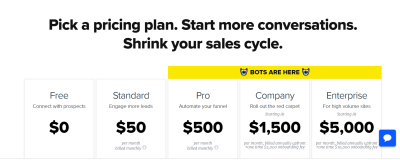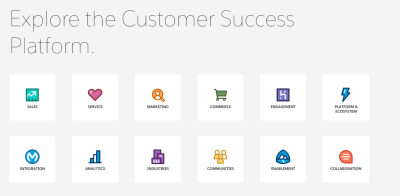What Does It Mean When You Make Things Again
(This article is sponsored past Adobe.) Kelly'southward in charge of choosing It deject services at her visitor. She has signed the visitor up for a chatbot service, and has had the "Pro" level service (not the "Free" or "Standard") for two years.
Information technology's time for the annual renewal. Volition she renew? Will she decide to renew, only switch to the complimentary service only? Is at that place anything about the electronic mail notice and/or webpage for the service that will either encourage her or discourage her from renewing?

There is a lot of research on human being decision-making. Here are some of my favorite insights from the research.
Most Decisions Are Non Made "Logically"
We similar to call up that we are logical and that when we are making a decision, we advisedly weigh all of our alternatives. When it'southward time to buy a new car, do we read all the specs and reviews, and choose the one that is the safest and almost economic? When it's time to renew the chatbot service, does Kelly do a study to see how much use she has made of the "Pro" services and evaluate whether she should stay with that level and pay that amount each month?
These would be the logical ways to brand the conclusion, and although we sometimes make decisions rationally and logically, there are hundreds of decisions we make every solar day, and we don't do a logical think through of every one. Even the large decisions where nosotros call back nosotros are being logical, the research shows that well-nigh of our decisions — big or minor — are fabricated unconsciously and involve emotion.
Here are some facts nearly decisions that may surprise you.
Most Of Our Decisions Are Made Unconsciously
Past looking at brain action while making a decision, researchers could predict what choice people would brand 7-10 seconds before they themselves were even aware of having made a decision. This means that even when people remember they are making a conscious, logical, decision, chances are that they aren't enlightened that they've already made a determination and that information technology was unconscious. We aren't even aware of our ain process.
Exercise you lot write your messaging and content to appeal to logical thinking?
If then, it'south possible and even probable that your logical, persuasive arguments to your target audience about why they should go with the premium service, or why they should purchase a particular product may be in vain.
Be suspicious of what people say.
Some other problem is that if y'all are diligent in your pattern process and ask people what factors are important to them, you lot might non be getting a true answer.
For example, if someone interviewed Kelly and asked her why she chooses the "Pro" level each yr, information technology is likely that she will come up with an answer that sounds very logical (i.eastward. about the service, how her visitor uses it and then on) when the real reason she stays with "Pro" rather than the "Free" program may be emotional ("I don't want to have things go wrong and if I pay coin things won't get wrong") or but habit ("It's what nosotros always sign up for"). What people tell yous is the reason for why they do what they practise may not be the actual reason.
People need to feel in order to decide.
If you tin't feel emotions, then you can't make decisions — thanks to our ventro-medial pre-frontal cortex (or 'vmPFC').
The vmPFC is function of the prefrontal cortex, i.e. the forepart of your brain. Information technology is important in regulating fear. Other parts of your brain (in item the amygdala) tell you lot when you should be afraid and what you should be agape of. The amygdala is where "conditioned" fear responses are born and perpetuated. The vmPFC, in contrast, has an opposite role. It mitigates conditioned fright. Information technology stops you lot from continuing to exist afraid in certain situations. When the vmPFC is active then yous are able to let go of conditioned fears. Every bit a event, y'all are then able to make a decision.
Y'all should just assume that all decisions involve emotions. Rather than just making logical arguments to persuade, you are more than likely to persuade people to take an action if you understand how they are feeling about the decision and feed their feeling. For case, if Kelly is feeling humble about making a wrong decision so your messaging should exist more about making her feel secure and safe than it is nigh product features.
People purchase when they feel confident of their decision.
There is really a neuron that fires up in the brain that triggers people to take activity when the brain decides it is confident of a decision. This is subjective. It's not necessarily based on the amount of information you've collected — it'south a feeling of confidence.
If you want people to accept an activeness then you need to make them feel confident. If you want Kelly to choose the "Pro" level again, then you need to give her messaging about the "Pro" version that makes her confident of her selection. For example, feed information back to her almost how much she has used the service. This volition make her feel confident that she is making the correct selection.
Don't Confuse Unconscious With Irrational Or Bad
I take exception with writers who equate unconscious conclusion making with making poor or irrational decisions. For case, Dan Ariely in his book, "Predictably Irrational: The Hidden Forces That Shape Our Decisions" implies that unless nosotros work hard to forbid it, many to most of our decisions are poor and irrational.
Most of our mental processing is unconscious, and nearly of our controlling is unconscious, only that doesn't hateful it's faulty, irrational, or bad. We are faced with an overwhelming amount of data (eleven,000,000 pieces of data come into the brain every second according to Dr. Timothy Wilson in his volume "Strangers To Ourselves: Discovering The Adaptive Unconscious") and our conscious minds can't process all of that.
Our unconscious has evolved to procedure most of the information and to make decisions for us according to guidelines and rules of pollex that are in our best interest almost of the time. This is the genesis of "trusting your gut", and most of the time it works!
People do like to retrieve that they are being logical and thorough, notwithstanding, so y'all may want to offer logical reasons for why a certain decision should be fabricated and so that the person making the decision has a rational reason they can give themselves and others. Get alee and requite Kelly the rational reasons she should renew for the "Pro" level, but simply understand that that reason is probably not the actual reason.
Recommended reading: Grabbing Visual Attention With The Visual Cortex
Only Give More than Data If People Are Making A Goal-Based Determination
There are two dissimilar types of decisions that people brand. Value-based decisions are fabricated in the orbitofrontal cortex (OFC). So, during those times when y'all actually are comparing the Honda to the Subaru when you are shopping for a car, and so y'all are making a value-based goal decision. If Kelly was comparing the features of the different levels for the chatbot service and then she would be making a value-based goal decision.
Habit-based decisions occur in the basal ganglia (deep in the encephalon). When yous pull your usual cereal off the shelf at the grocery shop and put information technology in your cart, that'south a habit-based decision. If Kelly presses the 'Renew' button for the Chatbot software then she is making a addiction-based conclusion.
What's interesting is that if the OFC is tranquility then the habit function of the brain takes over. This ways that people are either making a goal-directed decision or a addiction decision, just not both at the same fourth dimension.

If yous give someone a lot of data then they will switch from habit to goal-directed. So if you desire someone to brand a habit decision, don't give them besides much information to review. If you want them to make a goal-directed decision then do give them data to review.
If you want Kelly to renew for the "Pro" level then don't give her lots of data. Allow her make the addiction-based conclusion to renew. If yous are hoping that she will go upwards a level (not down) so you may desire to give her data on her options equally that will kick her from a habit decision to a goal-directed decision.
Likewise Many Choices Ways People Won't Choose
Yous may have heard the thought that people tin can just recollect, or deal with 7 plus or minus 2 things at a time (v to 9). This actually is not true. It was a theory offset mentioned by Miller in 1956 at a talk he gave at the American Psychological Clan meeting. But research since then shows that vii +- 2 is a myth. The real number is 3-iv non v-9. Refuting research includes:
- "The Magical Number 4 In Curt-Term Memory: A Afterthought Of Mental Storage Capacity," Nelson Cowan, Behavioral and Brain Sciences (2001)
- "The Magical Number Seven: Notwithstanding Magic After All These Years?," Alan Baddeley, Psychological Review (1994)
- "The Magic Number 7 Afterward 15 Years," Donald Broadbent, Wiley (1975)
And most recently, Sheena Iyengar (author of "The Art Of Choosing"), has conducted several studies that clearly bear witness that if you give people as well many choices so they end upwardly not choosing anything at all.
People liked having more choices to choose from but they were more satisfied with their choice when there was less to choose from.
And then, if you prove someone too many choices (in this example of sales/CRM services) they might not choose any and instead abandon the page.

Kelly was given five choices for the Chatbot service. Three to four would have been better.
So, is at that place annihilation you can do to encourage Kelly to re-subscribe and non alter her level of membership?
In this case, the determination is probably a habit-based decision. The best thing to do, then, is to not practice much at all. Don't send her an e-mail with information on all the membership levels. Instead, requite her one or two reasons why continuing with her current subscription is the way to get and leave information technology at that. At a different time (not when she is deciding whether to renew), you can brand a pitch for a college premium level. Simply if you do that pitch while she is most to renew, you may jeopardize her habit-based renewal.
Recommended reading: Don't Let Your Brain Deceive You: Avoiding Bias In Your UX Feedback
Takeaways
- If someone is making a habit-based decision, do not give them a lot of data.
- Provide people with a cursory, just a logical reason for their determination so they tin can utilize that to tell themselves and others why they did what they did.
- Limit the number of choices people have to make to i, 2 or iii. If you provide besides many choices so people probable won't cull at all.
This commodity is part of the UX design series sponsored past Adobe. Adobe XD tool is made for a fast and fluid UX pattern process, as it lets you lot go from idea to image faster. Design, paradigm and share — all in 1 app. Y'all can check out more inspiring projects created with Adobe XD on Behance, and too sign up for the Adobe experience design newsletter to stay updated and informed on the latest trends and insights for UX/UI design.
![]() (cm, ms, ra, il)
(cm, ms, ra, il)
Source: https://www.smashingmagazine.com/2019/02/human-decision-making/
0 Response to "What Does It Mean When You Make Things Again"
Postar um comentário